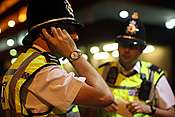Addressing antisocial behaviour

The most detailed analysis of the experiences and perceptions of victims of ASB ever conducted in this country has been used by a team at Cardiff to identify, for the first time, those police force areas where victims are at the greatest risk of harm from ASB.
Using data from a survey of 10,000 victims of anti-social behaviour, Professor Martin Innes and researchers at the Universities' Police Science Institute, School of Social Sciences, have profiled victims' vulnerabilities in order to better understand how, why and where certain disorder incidents occur, and their effects on the individuals targeted.
The research found that the risk of harm for ASB victims depended upon three factors: the nature of the ASB and whether it was personally targeted; victim personal characteristics such as their health; and the make-up of their local area. They also found that police forces differ from each other in the overall profile of their callers on characteristics of vulnerability and repeat victimisation.
The team's analysis highlights the police forces across the country that have the highest percentage of high repeat vulnerable victims (those who contacted police ten times or more about ASB problems during the previous 12 months).
By linking these findings with data from Her Majesty's Inspectorate of Constabulary about the quality of police force responses to ASB, the study identifies 'what works' for victims. The 4 key police actions being:
- Inter-personal interaction with the caller to establish who they are; where they are and what type of ASB they are experiencing.
- Linking this victim information with any previous contacts, with area data or previous intelligence to add depth and context to the victim report.
- Identification of risk and the deployment of resources, 'tailoring' responses according to the needs of the victim.
- Timely and appropriate feedback to the victim about what the police response was to their call with due consideration of the needs of the victim.
- Personal ASB – where victims consider it to be deliberately targeted at them personally, their family or a particular group they are part of - has the most significant negative impact on victims' quality of life and well-being;
- Repeat callers were often individuals who felt that their first report of antisocial behaviour had been, or continued to be, unsuccessful;
- In a third of police forces, 1 in 10 vulnerable victim callers have telephoned the police 10 or more times in a one-year period.
- 1 in 10 people who are vulnerable and repeat victims of ASB say they would not contact the police about issues in the future.
He continued: "By better understanding what factors contribute to vulnerability we are able to identify what police and other agencies can do to better manage ASB. We found that victims want to feel listened to, taken seriously, and to know what police action was taken as a result of their call. However, because some victims are more vulnerable and at risk than others, they do not all share the same 'starting place'. As such police should consider that in some area and for some victims they need to do more, or start doing things differently. This does not have to be resource-intensive. It could be offering greater reassurance, taking more time to communicate or communicating more frequently.
"Ultimately, at a time when police funding is being cut, this research shows how, by better understanding the needs of victims, police can 'work smarter' to improve victim satisfaction and public reporting of this type of crime."
Personal, Situational and Incidental Vulnerabilities to ASB Harm: A Follow Up Study is published by HMIC. It extends aspects of the work reported in the 2010 Universities' Police Science Institute report Rethinking the Policing of Antisocial Behaviour, that influenced HMIC's Stop the Rot report of that year.
More information: www.hmic.gov.uk/publication/pe … m-a-follow-up-study/
Provided by Cardiff University















